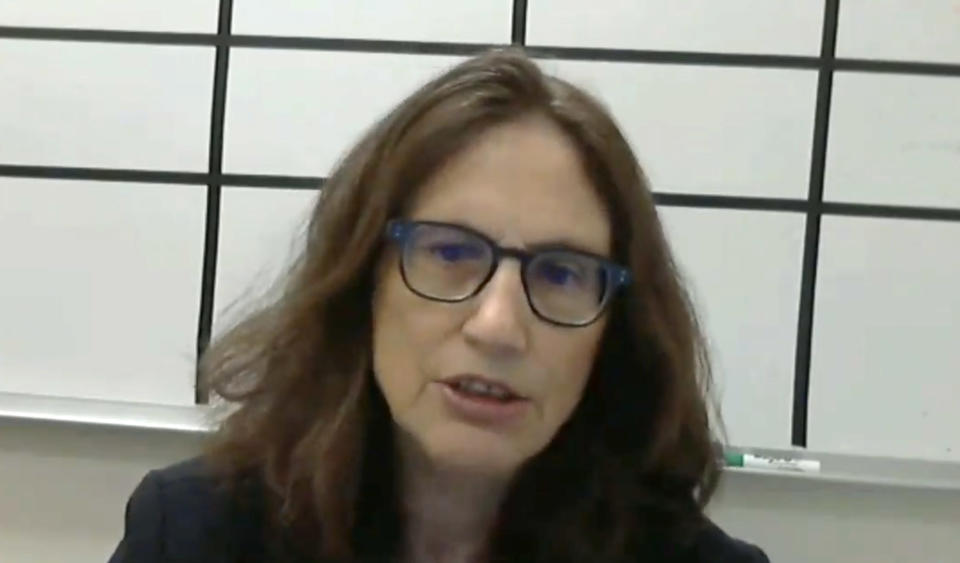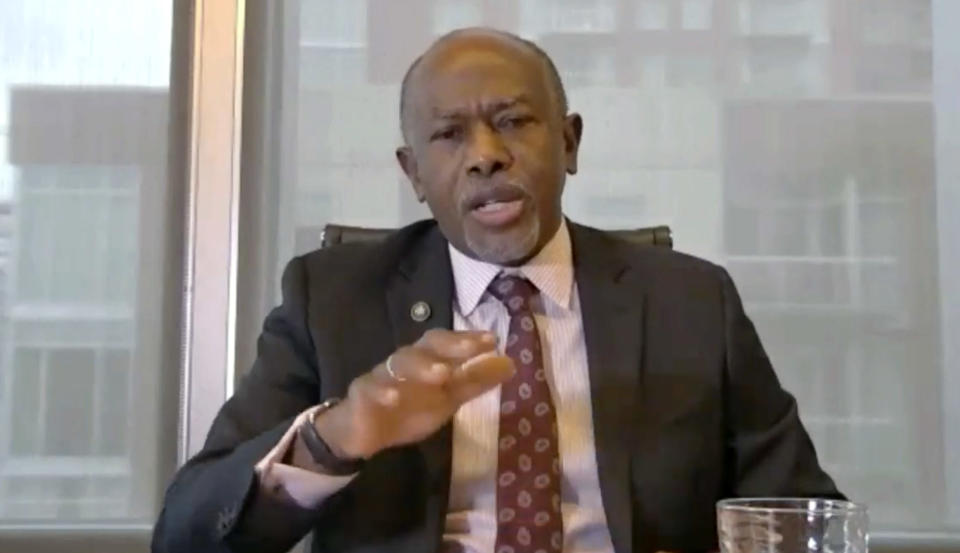Coronavirus is a 'racial pandemic,' doctors and scholars warn
WASHINGTON — Even as President Trump and many of his allies are rushing to reopen the nation from a months-long pandemic lockdown, that pandemic continues to devastate communities of color, a raft of witnesses warned legislators on Capitol Hill on Wednesday.
The pandemic, they said, was being compounded by long-standing government divestment in areas like health care and broadband Internet. Those warnings came as a stark rejoinder to images of crowded beaches in parts of Florida and California.
In fact, as some parts of the country recover, others remain in the heat of the battle against the coronavirus. But because some of those places, including prisons and Native American reservations, are largely out of public view, struggles with the coronavirus have been essentially invisible to the nation at large.
Wednesday’s hearing of the House Ways and Means Committee, conducted remotely and titled “The Disproportionate Impact of COVID-19 on Communities of Color,” was intended to highlight the fact that the disease that causes the coronavirus is far from a distant memory for many Americans. But by inviting a conservative economist as their witness — and referring frequently and favorably to his pro-reopening arguments — the committee’s Republicans seemed to indicate that their sole focus was on recovery.
Political forecasters believe that the extent and success of recovery from the pandemic, which has so far killed 100,000 Americans and left more than 30 million without jobs, will determine whether President Trump holds on to the White House and down ballot Republicans retain their seats. But for Democrats and many of their allies, talk of an economic recovery is premature.
Among the witnesses was Ibram X. Kendi, a professor at American University in Washington D.C., whose book, “How to Be an Antiracist,” has been widely praised for its recommendations on how to combat systemic racism. In his opening remarks to the committee — which conducted the hearing virtually — Dr. Kendi called the coronavirus a “racial pandemic within the viral pandemic.”

The Centers for Disease Control and Prevention, which has found a “disproportionate burden of illness and death among racial and ethnic minority groups,” appears to confirm that assertion. And a study by Amfar, the Foundation for Aids Research, found that majority-black counties accounted for nearly half of COVID-19 cases and 58 percent of COVID-19 deaths.
That same study posited some reasons for the high burden of disease on communities of color, black communities in particular, such as “health care access, density of households, unemployment [and] pervasive discrimination.” The researchers discounted “intrinsic characteristics of black communities or individual-level factors” as reasons for those high infection rates.
People of color are more likely to work jobs that have been deemed “essential,” including those in retail, agriculture and municipal services. Wealthier, whiter Americans, meanwhile, are more likely to have the kinds of jobs that allow them to work from home, thus avoiding situations where infection is likely.
Other witnesses drew attention to the needs of the communities with which they work. Dr. Alicia Fernandez of the University of California at San Francisco, for example, said that while telehealth was a promising development, unless Spanish-language services were available, such services would remain out-of-bounds for many in the Latinx population.

Dr. Raynal Samoa highlighted the plight of Pacific Islanders, whose multigenerational living arrangements he said made them more privy to contract the coronavirus. Dr. Samoa, an endocrinologist at the City of Hope cancer hospital in Los Angeles also described Pacific Islanders as especially susceptible to the disease because of what he said were their “extremely high rates of chronic disease such as diabetes, certain cancers and heart disease.”
Dr. Thomas Sequist, chief patient experience and equity officer at Mass General Brigham in Boston, painted a troubling portrait of how the coronavirus has ravaged Native American lands. Dr. Sequist, who belongs to the Taos Pueblo tribe of New Mexico, put the matter bluntly, in the form of a rhetorical question: “How do you battle a pandemic effectively without running water or electricity?”
Dr. Sequest was referring specifically to Navajo Nation, a native American reservation that in recent weeks has become a coronavirus hot spot. In fact, the reservation gained the distinction of having the highest per-capita infection rate in the nation. Previously, the highest infection rates had been recorded in and around New York City, which is both much more densely populated and has many more visitors than the impoverished Navajo communities of the Southwest.
This was the second day in a row that the Navajo Nation outbreak was discussed in a congressional hearing. The day before, Rep. Gerry Connolly, D-Va., pressed the inspector general of the Department of Health and Human Services to investigate how Zachary Fuentes, a former top aide to President Trump, won a contract to supply N95 respirators to two Navajo Nation hospitals. Fuentes has no experience in medical device procurement; some of the masks he supplied to the Navajo hospitals may not meet medical standards.
The sole Republican witness was Douglas Holtz-Eaken, a conservative economist who served as director of the Congressional Budget Office during the George W. Bush administration. Dr. Holtz-Eaken is a proponent of tax cuts, which tend to benefit wealthier individuals. In his opening statement, Dr. Holtz-Eaken advocated for a broad reopening of the economy, which he asserted would help all Americans.
Republicans returned to that argument repeatedly, for the most part avoiding substantive discussion of racial disparities. There is now a single Republican African-American member of Congress: Sen. Tim Scott of South Carolina.
While the hearing served to highlight racial disparities, there were few concrete proposals to correct them, given how deeply entrenched they are in American society. One novel proposal came from James Hildreth, who heads the Meharry Medical College in Nashville. (Meharry is a historically black college and university, or HBCU).

Dr. Hildreth suggested that the nations’ four black medical schools — Meharry, Howard University College of Medicine, Morehouse School of Medicine and Charles R. Drew Medical School — form a consortium of black medical schools. The consortium, Dr. Hildreth said, would “provide expanded testing, contact tracing, surveillance, training of frontline health workers, research and drug development, and policy recommendations to address the unique needs of vulnerable, low income, African American, and other underrepresented communities that have experienced disproportionate adverse outcomes due to the pandemic.”
Hildreth said that the legacy of medical experimentation on the African-American community, like the infamous Tuskegee syphilis study, have continued to erode trust in public health authorities. Nor did he think using the Tennessee National Guard to test people for the coronavirus in Nashville housing projects was an especially good idea, given the fraught history of law enforcement in black communities.
Dr. Hildreth asked for $5 billion for the effort. “I urge you to act now,” he told the lawmakers. “Too many have already died. More are dying as we sit here, in this moment, talking and not acting. Many more will die tomorrow if we dally.”
Cover thumbnail image: Ibram X. Kendi, Dr. Alicia Fernandez, Dr. Raynal Samoa, Douglas Holtz-Eaken, Dr. Thomas Sequist and Dr. James Hildreth testify during a video hearing before the House Ways and Means Committee on 'The Disproportionate Impact of COVID-19 on Communities of Color'. (House.gov via Yahoo News)
_____
Click here for the latest coronavirus news and updates. According to experts, people over 60 and those who are immunocompromised continue to be the most at risk. If you have questions, please refer to the CDC’s and WHO’s resource guides.
Read more:



